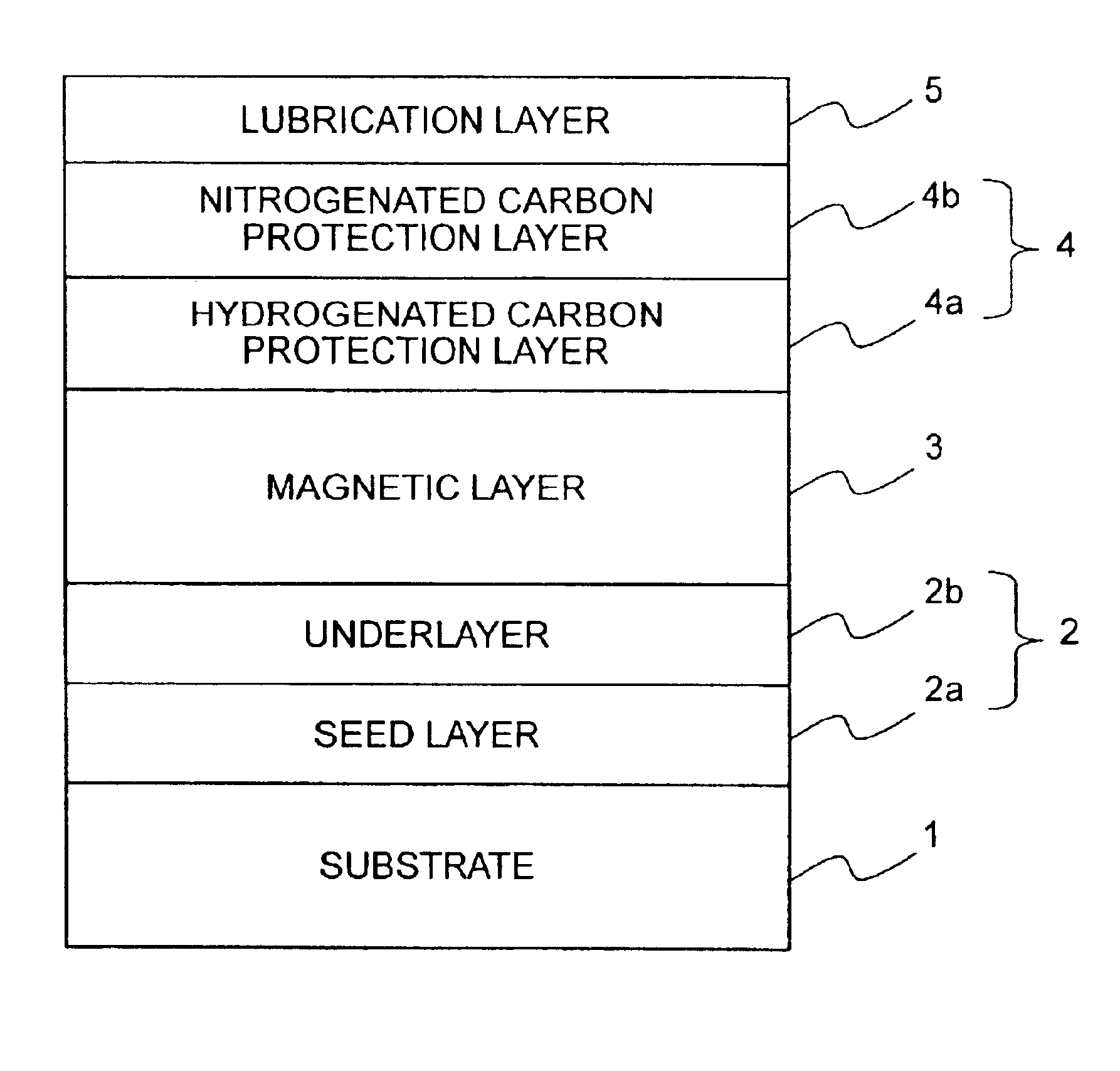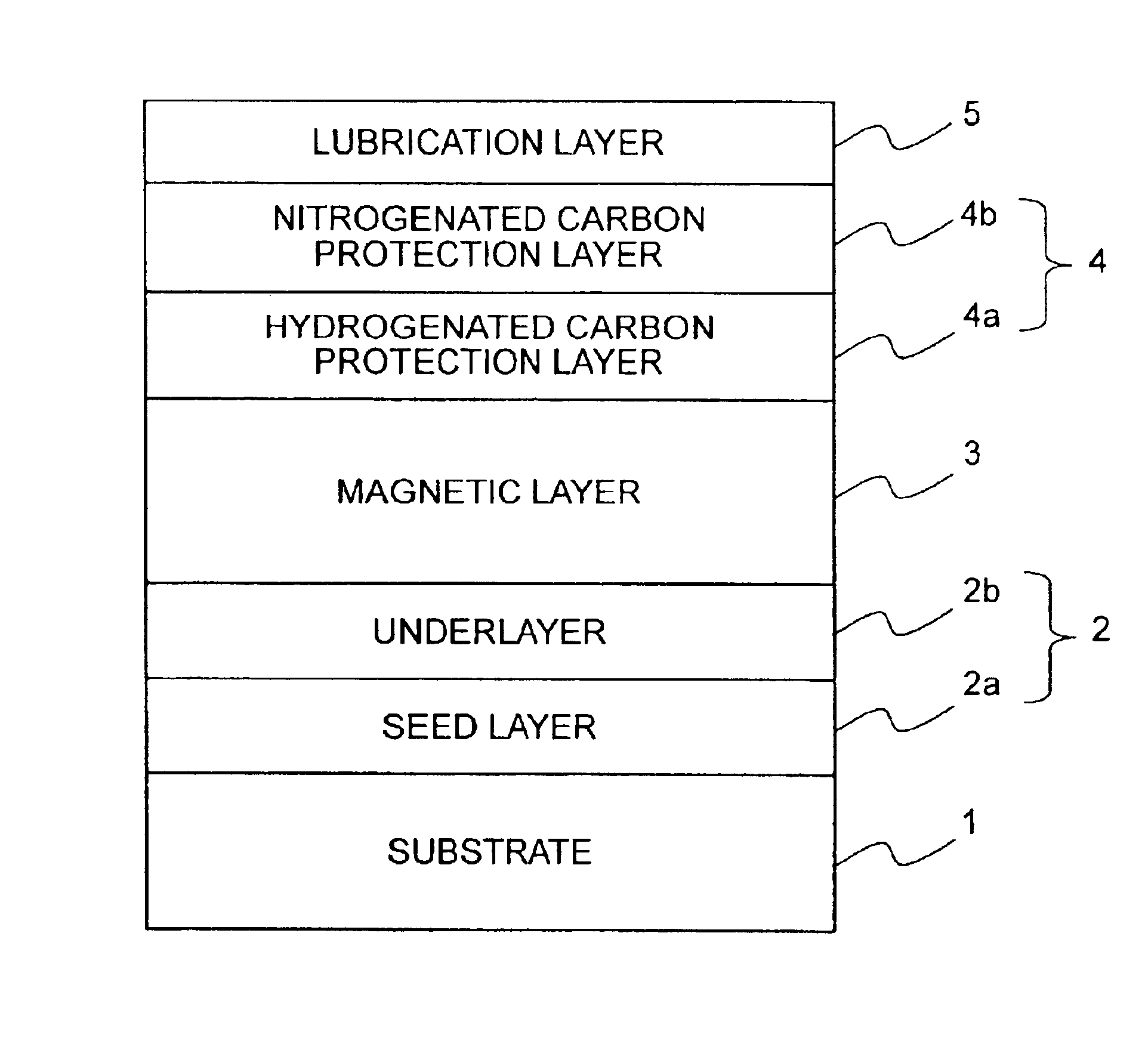Magnetic recording medium
a recording medium and magnetic technology, applied in the direction of magnetic recording, protective coatings for layers, instruments, etc., can solve the problems of inability to read, frequent reading errors, and inability to accurately detect the position so as to suppress the migration of contaminants and suppress the adhesion and fly stiction effect of the magnetic recording head
- Summary
- Abstract
- Description
- Claims
- Application Information
AI Technical Summary
Benefits of technology
Problems solved by technology
Method used
Image
Examples
example 1
[0098]An aluminosilicate glass was formed into a glass disk blank having a disk-like shape. The glass disk blank was successively subjected to grinding, precision polishing, and precision cleaning. In addition, the glass disk blank was chemically strengthened. As a result, the glass substrate 1 having a flat and clean surface was obtained.
[0099]By the use of an AFM (Atomic Force Microscope), the surface roughness of the glass substrate 1 was precisely measured. In order to obtain the result of measurement with high accuracy, a square area of 5 μm×5 μm was selected as a measured area. Furthermore, each side of the square area was divided into 512 meshes. For each dot, data sampling was carried out.
[0100]As a result, the surface roughness of the glass substrate was 5.04 nm in Rmax, 2.49 nm in Rp, 0.29 nm in Ra, and 0.37 nm in Rq.
[0101]The surface of the glass substrate was measured by a probe-type profilometer (Tencor P2). As a result, the surface profile of the glass substrate was no...
examples 2-5
[0136]In Examples 2-5, magnetic recording media were produced by the use of substrates and a production process similar to those described in conjunction with the magnetic recording medium of Example 1 except the following. Specifically, in Examples 2, 3, 4, and 5, the nitrogenated carbon protection layer 4b was formed by sputtering using a mixed gas containing the Ar gas and the nitrogen gas which had a concentration of 12.5%, 20%, 24%, and 31% so that the content of nitrogen in the nitrogenated carbon protection layer 4b was equal to 5 at %, 7 at %, 8 at %, and 10 at %, respectively. The flow rate of the mixed gas was 40 sccm. The magnetic recording media thus produced were subjected to characteristic evaluation and durability tests similar to those mentioned above. The results are shown in Table 1.
examples 6 and 7
[0137]In Examples 6 and 7, magnetic recording media were produced by the use of substrates and a production process similar to those described in conjunction with the magnetic recording medium of Example 1 except the following. Specifically, in both of Examples 6 and 7, the nitrogenated carbon protection layer 4b was formed by sputtering using a mixed gas containing the Ar gas and the nitrogen gas which had a concentration of 16% so that the content of nitrogen in the nitrogenated carbon protection layer was equal to 6 at %. The flow rate of the mixed gas was 40 sccm. In the magnetic recording medium of Example 6, the nitrogenated carbon protection layer 4b had a thickness of 1 angstrom. In the magnetic recording medium of Example 7, the nitrogenated carbon protection layer 4b had a thickness of 15 angstroms. The magnetic recording media thus produced were subjected to characteristic evaluation and durability tests similar to those mentioned above. The results are shown in Table 1.
[...
PUM
| Property | Measurement | Unit |
|---|---|---|
| thickness | aaaaa | aaaaa |
| thickness | aaaaa | aaaaa |
| flying height | aaaaa | aaaaa |
Abstract
Description
Claims
Application Information
 Login to View More
Login to View More - R&D
- Intellectual Property
- Life Sciences
- Materials
- Tech Scout
- Unparalleled Data Quality
- Higher Quality Content
- 60% Fewer Hallucinations
Browse by: Latest US Patents, China's latest patents, Technical Efficacy Thesaurus, Application Domain, Technology Topic, Popular Technical Reports.
© 2025 PatSnap. All rights reserved.Legal|Privacy policy|Modern Slavery Act Transparency Statement|Sitemap|About US| Contact US: help@patsnap.com


